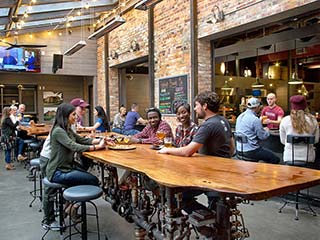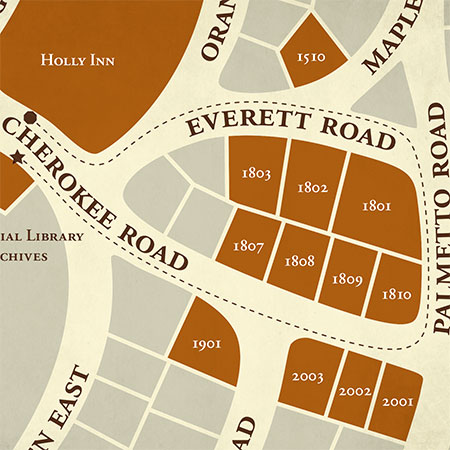A U.S. Open Year
A U.S. Open Year
By Lee Pace
They overcame a litany of headwinds to stage that first U.S. Open in Pinehurst back in 1999.
Could a small town support a national championship and the attendant influx of competitors, officials, sponsors, spectators, media and volunteers? Indeed it could if the boundaries were expanded and it became a State of North Carolina event. Pat Corso, the Pinehurst Resort CEO at the time, and his staff argued that Pinehurst was not, in fact, “in the middle of nowhere,” but was actually in “the middle of everywhere” — pointing to North Carolina’s vibrant Piedmont Crescent region that ran from Charlotte to Raleigh and had more than six million citizens in its midst within a two-hour drive of the Sandhills.
 Could the No. 2 course, shunned as a potential Open venue for decades by USGA officials because of the course’s inability to foster quick, firm greens in mid-June in the South, stand up to the modern game, just at as it had during its North & South Open heyday of the first half of the 1900s? The answer was a rounding yes, as Pinehurst and USGA agronomists used an updated version of bent grass on the greens that required less water and could be trimmed tight and into firm-and-fast fettle. Just one player, champion Payne Stewart, broke par for 72 holes.
Could the No. 2 course, shunned as a potential Open venue for decades by USGA officials because of the course’s inability to foster quick, firm greens in mid-June in the South, stand up to the modern game, just at as it had during its North & South Open heyday of the first half of the 1900s? The answer was a rounding yes, as Pinehurst and USGA agronomists used an updated version of bent grass on the greens that required less water and could be trimmed tight and into firm-and-fast fettle. Just one player, champion Payne Stewart, broke par for 72 holes.
The result was a blend of competition, logistics and ambiance that captured the nation’s fancy and set Pinehurst up for the next quarter century and beyond.
“What’s struck me is how this community has absorbed the event, yet remained the same,” Corso said on the final day of the competition. “Anybody coming here I think gets the full impact and charm of the community. At many places that host major events, you don’t get the sense of the community at all. You’re tucked in some suburb or you’re in a neighborhood and it’s compacted and you don’t get a sense of, ‘Where are you?’ People didn’t just come to Pinehurst to a golf course for an event. They came here actually to share in the Pinehurst experience. I think that is pretty neat.”
Added David Fay, the president of the USGA: “The Open at Pinehurst could be Tracy and Hepburnesque — a match made in heaven, the first of many.”
 The 1999 Open promised a texture and personality unlike anything the nation’s most prestigious championship had seen before. Pinehurst is no old-moneyed Eastern club with greenside rough shaggy enough to obscure a small dog. It lacks the eucalyptus trees and Pacific whitecaps reminiscent of the prestigious West Coast sites. There’s no metropolitan area nearby, either. Raleigh, the state capital of North Carolina, is 70 miles away and Charlotte, the state’s biggest city, is 100.
The 1999 Open promised a texture and personality unlike anything the nation’s most prestigious championship had seen before. Pinehurst is no old-moneyed Eastern club with greenside rough shaggy enough to obscure a small dog. It lacks the eucalyptus trees and Pacific whitecaps reminiscent of the prestigious West Coast sites. There’s no metropolitan area nearby, either. Raleigh, the state capital of North Carolina, is 70 miles away and Charlotte, the state’s biggest city, is 100.
The Pinehurst elixir is two-fold. The village and club offer a blend of history and aesthetics and devotion to the game of golf that set a perfect table for such a competitive feast.
“What Madison Square Garden has been to boxing, what Harvard Stadium has been to football and track athletics, what Belmont, Saratoga and Churchill Downs mean to racing, Pinehurst means to golf,” Golf World magazine founder Bob Harlow said in 1938.
So here we are on the cusp of a new year, with the fourth U.S. Open for Pinehurst No. 2 set to commence the third week of June. And though much has changed in the Sandhills golf scene during the last decade (more on that to come), the essence of the Village and its spirit are securely intact.
The ingress from points beyond is still captivating. Judy Bell, the USGA president in 1996-97, traveled to Southern Pines to visit her friend Peggy Kirk Bell at Pine Needles dozens of times throughout the years. “You leave Raleigh and start driving down there and you get excited the closer you get,” she says. “You get in the Sandhills and you start to smell it. I love it.”
Adds former Wake Forest golf coach Jesse Haddock, who brought his Demon Deacon teams to Pinehurst every spring in the 1970s and ‘80s for the Pinehurst Intercollegiate: “There’s something about Pinehurst. You turn off Hwy. 5 and go into the Village, there’s an aura or something that gets to all five senses.”
 Carolina Vista, the peaceful avenue that runs from the roundabout on Hwy. 2 to the Carolina Hotel through a canopy of pines and hollies, looks the same today it did in 1924. In the distance looms the majestic, 124-year-old hotel with its signature copper cupola glistening in the sun.
Carolina Vista, the peaceful avenue that runs from the roundabout on Hwy. 2 to the Carolina Hotel through a canopy of pines and hollies, looks the same today it did in 1924. In the distance looms the majestic, 124-year-old hotel with its signature copper cupola glistening in the sun.
“Turning down Carolina Vista headed to the hotel, it was like going back in time,” says May Wood, the 2002 Women’s North & South Amateur champion. “It was electrifying. I almost teared up the first time I saw it. It was the most beautiful place I’d ever been.”
The Village of Pinehurst is a National Historic Landmark and keeps company with such places as Alcatraz Island, the Rose Bowl, the Grand Canyon, the Alamo, Carson City, St. Patrick’s Cathedral, The White House, Cape Canaveral, Cape Hatteras Light Station and Paul Revere House. There are no right angles in the street patterns and only white and forest green fences and sign posts. The architecture harkens to its New England roots with arched doorways, Colonial Revival facades, the sharply pitched roofs and the gables, cedar and redwood trim, cabins built of juniper logs and original heart-pine columns of the “Casino” building (now a real-estate agent’s office).
Visitors to Pinehurst in June will ask the quintessential question: Why? Why is this here? The local newspaper acknowledged the mystery as far back as 1909. Pinehurst, it said, was “an oasis in the desert.”
 “It just doesn’t make any sense,” says native and lifelong resident and businessman Marty McKenzie. “There are no mountains, no ocean, no river, no economic reason, no natural reason. I once heard someone say about Iowa, ‘The soil is so rich you want to grab a handful and eat it.’ Wow. There’s nothing rich about this soil, I’ll tell you that. It was so barren even the settlers passed it by.
“It just doesn’t make any sense,” says native and lifelong resident and businessman Marty McKenzie. “There are no mountains, no ocean, no river, no economic reason, no natural reason. I once heard someone say about Iowa, ‘The soil is so rich you want to grab a handful and eat it.’ Wow. There’s nothing rich about this soil, I’ll tell you that. It was so barren even the settlers passed it by.
“When we try to describe something, we always use the five senses. ‘It looks like …’ ‘It tastes like …’ ‘It feels like …’ But when you try to describe Pinehurst to other people and you say, ‘It looks like ….,’ you can’t find anything. Nothing comes to mind. It doesn’t look like anything you’ve ever seen before.”
That, of course, is the charm. The year 2024 will provide ample reminders.
Golf writer Lee Pace has written about golf in the Sandhills for four decades and has authored books on the history of Pinehurst Resort, Pine Needles, Mid Pines and Forest Creek.
Read about The Dynamic Decade
Read about “New” Pinehurst Welcomes World in 2024




